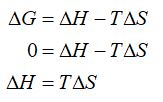At room temperature when HI (aq) is added to potassium bisulfite, KHSO3(s), sulfur dioxide is formed and the reaction vessel becomes cold. HI (aq) + KHSO3(s)→ SO2(g) + H2O(l) + K+(aq) + I-(aq). A.)Once the process has reached equilibrium at room temperature, which of the following must be true? choose one....(ΔH<TΔS, ΔH=TΔS, ΔH>TΔS, or need more info). B.) Once the process has reached equilibrium at room temperature, which of the following must be true? choose one....(ΔSuniv<0, ΔSuniv=0, ΔSuniv>0, or need more info).
At room temperature when HI (aq) is added to potassium bisulfite, KHSO3(s), sulfur dioxide is formed and the reaction vessel becomes cold. HI (aq) + KHSO3(s)→ SO2(g) + H2O(l) + K+(aq) + I-(aq). A.)Once the process has reached equilibrium at room temperature, which of the following must be true? choose one....(ΔH<TΔS, ΔH=TΔS, ΔH>TΔS, or need more info). B.) Once the process has reached equilibrium at room temperature, which of the following must be true? choose one....(ΔSuniv<0, ΔSuniv=0, ΔSuniv>0, or need more info).
Chemistry
10th Edition
ISBN:9781305957404
Author:Steven S. Zumdahl, Susan A. Zumdahl, Donald J. DeCoste
Publisher:Steven S. Zumdahl, Susan A. Zumdahl, Donald J. DeCoste
Chapter1: Chemical Foundations
Section: Chapter Questions
Problem 1RQ: Define and explain the differences between the following terms. a. law and theory b. theory and...
Related questions
Question
At room temperature when HI (aq) is added to potassium bisulfite, KHSO3(s), sulfur dioxide is formed and the reaction vessel becomes cold. HI (aq) + KHSO3(s)→ SO2(g) + H2O(l) + K+(aq) + I-(aq).
A.)Once the process has reached equilibrium at room temperature, which of the following must be true? choose one....(ΔH<TΔS, ΔH=TΔS, ΔH>TΔS, or need more info).
B.) Once the process has reached equilibrium at room temperature, which of the following must be true? choose one....(ΔSuniv<0, ΔSuniv=0, ΔSuniv>0, or need more info).
Expert Solution
Step 1
(A)
The system is at equilibrium means the free energy change of the system is equal to zero. Hence, the relation between enthalpy and entropy change can be obtained as,

Step by step
Solved in 2 steps with 1 images

Knowledge Booster
Learn more about
Need a deep-dive on the concept behind this application? Look no further. Learn more about this topic, chemistry and related others by exploring similar questions and additional content below.Recommended textbooks for you

Chemistry
Chemistry
ISBN:
9781305957404
Author:
Steven S. Zumdahl, Susan A. Zumdahl, Donald J. DeCoste
Publisher:
Cengage Learning

Chemistry
Chemistry
ISBN:
9781259911156
Author:
Raymond Chang Dr., Jason Overby Professor
Publisher:
McGraw-Hill Education

Principles of Instrumental Analysis
Chemistry
ISBN:
9781305577213
Author:
Douglas A. Skoog, F. James Holler, Stanley R. Crouch
Publisher:
Cengage Learning

Chemistry
Chemistry
ISBN:
9781305957404
Author:
Steven S. Zumdahl, Susan A. Zumdahl, Donald J. DeCoste
Publisher:
Cengage Learning

Chemistry
Chemistry
ISBN:
9781259911156
Author:
Raymond Chang Dr., Jason Overby Professor
Publisher:
McGraw-Hill Education

Principles of Instrumental Analysis
Chemistry
ISBN:
9781305577213
Author:
Douglas A. Skoog, F. James Holler, Stanley R. Crouch
Publisher:
Cengage Learning

Organic Chemistry
Chemistry
ISBN:
9780078021558
Author:
Janice Gorzynski Smith Dr.
Publisher:
McGraw-Hill Education

Chemistry: Principles and Reactions
Chemistry
ISBN:
9781305079373
Author:
William L. Masterton, Cecile N. Hurley
Publisher:
Cengage Learning

Elementary Principles of Chemical Processes, Bind…
Chemistry
ISBN:
9781118431221
Author:
Richard M. Felder, Ronald W. Rousseau, Lisa G. Bullard
Publisher:
WILEY